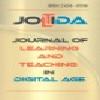Integrating Engineering, Science, Reading, and Robotics across Grades 3-8 in a STEM Education Era
Integrating Engineering, Science, Reading, and Robotics across Grades 3-8 in a STEM Education Era
STEM Computational thinking, Engineering design, Nature of engineering, Robotics, Coding,
___
- American Association for the Advancement of Science. (1993). Benchmarks for science literacy: Project 2061. New York: Oxford University Press.
- Akerson, V. L., Burgess, A., Gerber, A., Guo M., Khan, T.A., & Newman, S. (2018). Disentangling the meaning ofSTEM: Implications for Science Education and Science Education Research. Journal of Science Teacher Education, 29(1), 1-8.
- Beheshti, E., Weintrop, D., Swanson, H., Orton, K., Horn, M., Jona, K., Trouille, L., & Wilensky, U. (2017). Computational Thinking in Practice: How STEM Professionals Use CT in Their Work. Paper presented in the Annual Meeting of the American Education Research Association. Paper retrieved from https://par.nsf.gov/servlets/purl/10026245
- Bybee, R. W. (2013). The case for STEM education: Challenges and opportunities. Arlington, VA: Q11 NSTA Press.
- Conderman, G., & Woods, S. (2008). Science Instruction: An Endangered Species. Kappa Delta Pi Record, 44(2), 76- 80.
- Dillon, S. (March 26, 2006). Schools push back subjects to push reading and math. New York Times. http://nytimes.com/2006/03/26/education/26child.html?pagewanted=1&_r=1
- Duke, N. & Pearson, P. D. (2002). Effective practices for developing reading comprehension. In Farstrup, A. E. & Samuels, S. J. (Eds.), What research has to say about reading instruction (pp.205-242). Newark, DE: International Reading Association.
- Johnson. C. C. (2012). Implementation of STEM Education Policy: Challenges, Progress, and Lessons Learned. School Science and Mathematics, 102(1), 45-55.
- Keefe, B. (2010). The perception of STEM: Analysis, issues and future directions. Entertainment and Media Industries Council.
- Kemple, J. J., Corrin,W., Nelson, E., Salinger, T., Herrmann, S., & Drummon, K. (2008). The Enhanced Reading Opportunities Study: Early Impacts and Implementation Findings (NCEE 2008-4015). Washington, DC: U.S. Department of Education, Institute of Education Sciences, National Center for Education Evaluation and Regional Assistance.
- Gamse, B.C., Jacob, R.T., Horst, M., Boulay, B., and Unlu, F. (2008). Reading First Impact Study Final Report (NCEE 2009-4038). Washington, DC: National Center for Education Evaluation and Regional Assistance, Institute of Education Sciences, U.S. Department of Education. https://ies.ed.gov/ncee/pdf/20094038.pdf
- Lederman, N.G. (2007). Nature of science: Past, present, and future. In S.K. Abell, & N.G. Lederman, (Eds), Handbook of research on science education, (pp. 831-879). Mahwah, NJ: Erlbaum.
- McMurrer, J. (February 20, 2008). NCLB Year 5: Instructional Time in Elementary Schools: A Closer Look at Changes for Specific Subjects. Center on Education Policy. https://www.cepdc.org/displayDocument.cfm?DocumentID=309
- McNeill, N. J., Douglass, E. P., Koro-Ljunberg, M., Therriault, D., & Krause, I. (2016). Undergraduate students’ beliefs about engineering problem solving. Journal of Engineering Education, 105(4), 560-584.
- NGSS Lead States (2013). Next Generation Science Standards: For states, by states. Washington, DC: National Academies Press.
- National Resource Council (1996). National Science Education Standards, Washington D.C.: National Academy Press.
- National Research Council. (2000). Inquiry and the national science education standards: A guide for teaching and learning. Washington, DC: National Academy Press.
- Pratt, H. (2007). Science education’s overlooked ingredient: Why the path to global competitiveness begins in elementary school. NSTA Press. http://science.nsta.org/nstaexpress/nstaexpress_2007_10_29_pratt.htm Accessed November 14, 2013.
- Swanson, H., Anton, G., Bain, C., Horn, M., & Wilensky, U. (2017). Computational thinking in science classroom. Paper presented in the International Conference on Computational Thinking Education. Retrieved from https://www.eduhk.hk/cte2017/doc/CTE2017%20Proceedings.pdf
- Vasquez, J., A., Sneider, C., & Comer, M. (2013). STEM Lesson Essentials: Integrating Science, Technology, Engineering, and Mathematics. Portsmouth, NH: Heinemann.
- Weintrop, D., Beheshti, E., Horn, M., Orton, K., Jona, K., Trouille, L., & Wilensky, U. (2016). Defining computational thinking for mathematics and science classrooms. Journal of Science Education and Technology, 25(1), 127- 147.
- Wheatley, K. F. (2002). The potential benefits of teacher efficacy doubts for educational reform. Teaching and Teacher Education, 18(1), 5-22.
- Wilensky, U., Brady, C. E., & Horn, M. S. (2014). Fostering computational literacy in science classrooms. Communications of the ACM, 57(8), 24-28.
- Wing, J. M. (2006). Computational thinking. Communications of the ACM, 49(3), 33–35.
- Yayın Aralığı: 2
- Başlangıç: 2016
- Yayıncı: Mehmet Akif Ocak
Esra Çoban BUDAK, Aynur Kolburan GEÇER, Arzu Deveci TOPAL
Adapted text benefits for teachers and students: A retroactive case study
The Perceived Benefit of a 3D Anatomy Application (App) in Anatomy Occupational Therapy Courses
Integrating Engineering, Science, Reading, and Robotics across Grades 3-8 in a STEM Education Era
Hasan DENİZ, Erdogan KAYA, Ezgi YESİLYURT, Anne NEWLEY, Emily LİN
Data Science and Human Behaviour Interpretation and Transformation
Evrim ÜSTÜNLÜOĞLU, Robert DAHLGREN
Agâh Tuğrul KORUCU, Kadir KABAK
